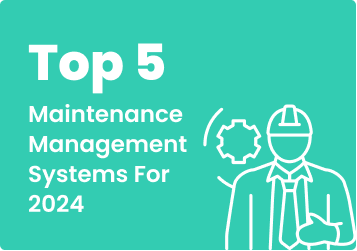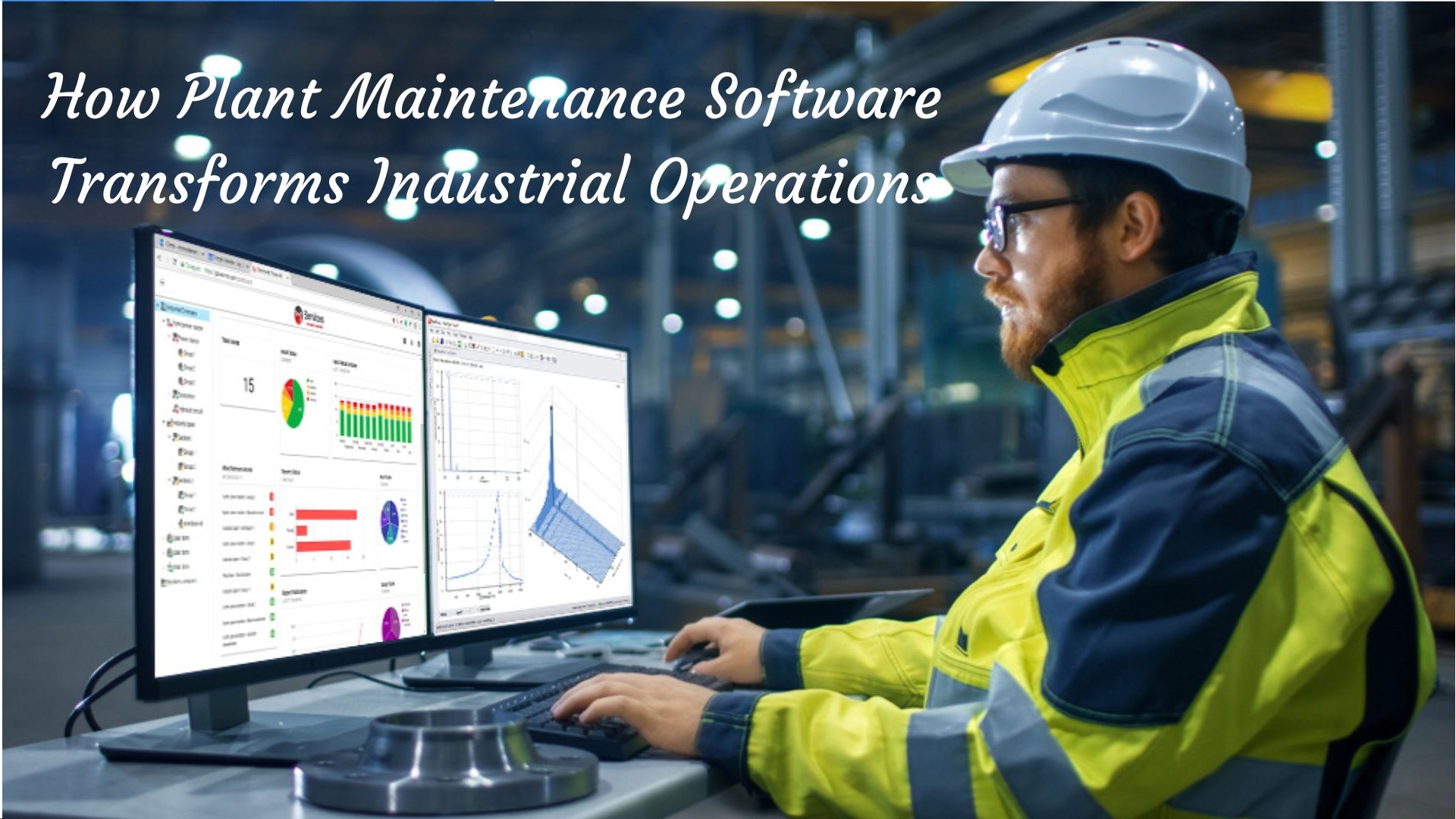
Top 5 Maintenance Management Systems for 2024
Kirti Prakash |
27 Jun 2024 |
09:47 AM
- What is a Maintenance Management System?
- Why Do You Need a Maintenance Management System?
- Key Features to Look for in a Maintenance Management Software
- Types of Maintenance Management Systems
- Top 5 Maintenance Management Systems for 2024
- How to Implement a Maintenance Management System in Your Operations
- Conclusion

How Plant Maintenance Software Transforms Industrial Operations
Madhurima Sanyal 09 Jun 2024 | 07:17 AMExplore the potential of Plant Maintenance Software, and how it is revolutionizing your industrial facility's efficiency. Discover predictive maintenance, asset tracking, and real-time reporting for a seamless, high-quality operation. ...
Is your factory stuck in a cycle of breakdowns and frantic repairs?
Do you often visualise this? - Your machines run smoothly, every day. No more scrambling to fix surprise failures or drowning in paperwork.
Well, this isn't a dream; it's the reality with a powerful maintenance management system (MMS) in your corner.
Stop wasting money on downtime and frustrated technicians!
Traditional maintenance just can't keep up in today’s competitive manufacturing world. But there's a solution: sophisticated softwares like Proptor that streamlines everything from work orders to equipment lifespans.
Get ready to dive into this blog - it reveals the top 5 maintenance management systems for 2024.
We will cover how they conquer common challenges, from scheduling nightmares to unexpected breakdowns. Whether you need a system to automate tasks or gain complete control, we've got you covered.
What is a Maintenance Management System?
Maintenance Management Software is like a helpful organiser for all your machine maintenance. It makes planning, keeping track of, and fixing things much smoother!
These systems centralise all maintenance-related data, making it easy to manage everything from routine inspections to emergency repairs.
With an MMS, you can:
- Schedule preventive maintenance
- Monitor equipment performance
- Ensure timely repairs, all from one integrated platform
In an industry where operational efficiency is crucial, these systems are vital for minimising downtime and maximising productivity.
Benefits:
By proactively managing maintenance tasks, you can:
- Prevent equipment failures
- Reduce the risk of costly breakdowns
- Extend the lifespan of your machinery.
This saves you money and keeps your factory running like a well-oiled machine, with no surprises to slow things down!
Plus, everyone on your maintenance team will be on the same page, working together to keep things running smoothly!
Why Do You Need a Maintenance Management System?
Investing in a maintenance management system offers a host of benefits that can transform your operations. Here's why you need one:
- Improved Asset Longevity: Regular inspections and timely repairs prevent small issues from becoming major problems, ensuring your assets stay in top condition for longer.
- Reduced Downtime: A maintenance management system helps you schedule preventive maintenance and track equipment performance, drastically reducing the risk of unplanned downtime.
- Better Resource Management: With a maintenance management system, you can allocate your maintenance teams, tools, and spare parts more effectively. This ensures that your resources are used optimally, reducing waste and improving efficiency.
- Enhanced Compliance: Maintenance management software solutions help you keep detailed records of all maintenance activities, inspections, and repairs. This not only ensures compliance but also provides you with the documentation needed for audits and reports.
A maintenance management system also streamlines your workflows, making your operations more productive.
Automated scheduling and real-time updates reduce the administrative burden on your team. This allows them to focus on their core tasks.
Improved communication and collaboration tools ensure everyone is on the same page, minimising misunderstandings and delays.
Key Features to Look for in a Maintenance Management Software
- Asset Tracking and Management: You can easily monitor the status, location, and maintenance history of all your equipment, ensuring nothing slips through the cracks.
- Work Order Management: Efficient work order management is crucial. Look for a system that allows you to create, assign, and track work orders seamlessly. This ensures that all maintenance tasks are completed on time and nothing gets overlooked.
- Preventive and Predictive Maintenance: To keep your operations running smoothly, your MMS should support both preventive and predictive maintenance. By scheduling regular maintenance and using data to predict potential failures, you can avoid costly downtime and extend the life of your equipment.
- Integration Capabilities: Your maintenance management system should integrate easily with other systems you use, such as ERP, CRM, or inventory management software. This ensures a seamless flow of information and enhances overall efficiency.
- User-Friendly Interface and Mobile Accessibility: A user-friendly interface is essential for ensuring that your team can quickly learn and use the system. Additionally, mobile accessibility allows your team to access the MMS on-the-go, making it easier to manage maintenance tasks from anywhere.
- Reporting and Analytics: Comprehensive reporting and analytics tools are vital for making informed decisions. Your MMS should provide detailed reports on maintenance activities, asset performance, and other key metrics, helping you identify trends and areas for improvement.
Types of Maintenance Management Systems
-
Enterprise Asset Management (EAM)
Enterprise Asset Management (EAM) integrates maintenance management with overall asset management. It's designed to oversee the entire lifecycle of your assets, from acquisition to disposal.
Examples: IBM Maximo, Infor EAM
Benefits:
EAM systems offer comprehensive asset lifecycle management and seamless integration with other enterprise systems, providing a holistic view of asset performance and maintenance needs
-
Facilities Management Systems (FMS)
Facilities Management Systems (FMS) are specifically designed for managing building and facility maintenance. They focus on maintaining the physical spaces and infrastructure of an organisation.
Examples: Archibus, FMX.
Benefits:
FMS provides space management, maintenance tracking, and efficient resource allocation, ensuring that your facilities are well-maintained and optimally utilised.
-
Field Service Management (FSM)
Field Service Management (FSM) systems manage maintenance tasks for field-based operations. They are essential for organisations with mobile workforces and remote job sites.
Examples: ServiceMax, Salesforce Field Service.
Benefits: FSM systems excel in scheduling, dispatching, and providing mobile access for field technicians, enhancing efficiency and responsiveness in field operations.
-
Integrated Workplace Management Systems (IWMS)
Integrated Workplace Management Systems (IWMS) combine maintenance management with workplace resource management. These systems are designed to optimise the use of workplace resources.
Examples: Planon, Trimble Manhattan.
Benefits: IWMS offers real estate management, space utilisation, and maintenance management, providing a comprehensive approach to managing your workplace environment.
-
Computerised Maintenance Management Systems (CMMS)
We will explore which CMMS options stand out as the best for 2024. In this blog we will discuss top 5 CMMS software solutions, examining their features, benefits, and how they can elevate your maintenance strategy.
Computerised Maintenance Management Systems (CMMS) focus on automating maintenance management processes. They are designed to streamline and optimise maintenance tasks.
Examples: eMaint CMMS, Proptor.
Benefits: CMMS provides real-time tracking, preventive maintenance scheduling, and mobile access, ensuring that your maintenance operations are efficient and proactive.
Top 5 Maintenance Management Systems for 2024
1. Proptor
Proptor is designed for seamless and efficient operations management, making it a top choice for businesses looking to enhance their maintenance processes.
Key Features:
- CMMS analytics
- Inspections
- Work orders
- Asset management
- Inventory tracking
- Comprehensive maintenance solutions
Benefits:
- User-friendly interface
- Streamlined feedback processes
- Robust customer support
Why Choose Proptor?
Proptor stands out for its ability to simplify operations and provide valuable insights, optimising daily operations and maintenance for over 10,000 users. It’s designed to meet the needs of modern businesses, ensuring that you can maintain efficiency and productivity in your operations.
2. eMaint
eMaint CMMS is a cloud-based CMMS with extensive customization options, designed to meet the unique needs of your business.
Key Features:
- Asset management
- Work order tracking
- Preventive maintenance scheduling
- Mobile access
Benefits:
- Customizable dashboards
- Real-time updates
- Scalable solutions
Why Choose eMaint?
eMaint is known for its flexibility and ease of use, making it suitable for various industries. Whether you need a simple maintenance tracking system or a comprehensive cloud-based maintenance management software, eMaint can adapt to your requirements.
3. Fiix
Fiix is an AI-driven maintenance management software known for its powerful integration capabilities.
Key Features:
- Real-time reporting
- Mobile capabilities
- Easy integration with existing systems
Benefits:
- Robust analytics
- User-friendly design
- Flexible pricing
Why Choose Fiix?
Fiix is ideal for organisations seeking advanced features and ease of integration. Its AI-driven insights and flexible options make it a top choice for optimising maintenance operations.
4. Maintenance Connection
Maintenance Connection is a comprehensive CMMS designed for large-scale operations.
Key Features:
- Detailed asset management
- Inventory control
- Comprehensive reporting
Benefits:
- High scalability
- Strong customer support
- Intuitive user interface
Why Choose Maintenance Connection
Trusted by large enterprises for its reliability and extensive feature set, Maintenance Connection is perfect for managing complex maintenance needs with efficiency and ease.
5. Hippo CMMS
Hippo CMMS offers an affordable and easy-to-use CMMS solution tailored for small to mid-sized businesses.
Key Features:
- Work order management
- Maintenance scheduling
- User-friendly interface
Benefits:
- Cost-effective
- Intuitive design
- Excellent customer support
Why Choose Hippo CMMS?
Hippo CMMS is best for businesses seeking a straightforward and effective maintenance management solution, offering essential features without the complexity or high costs.
How to Implement a Maintenance Management System in Your Operations
Implementing a maintenance management system in your operations involves several crucial steps to ensure success and maximise benefits.
Steps for Successful Implementation
- Assessment: Determine the specific needs and goals of your organisation to choose the right maintenance planning systems.
- Planning: Develop a detailed implementation plan. This should include a timeline, resource allocation, and key milestones.
- Training: Comprehensive training material includes hands-on training sessions, user manuals, and ongoing support to address any issues that arise during the transition.
- Continuous Improvement: Continuously monitor the system’s performance and gather feedback from users. Use this data to make necessary adjustments and improvements.
Tips for Maximising Benefits:
- Leverage Analytics: The analytics and reporting features of your maintenance management software will help you identify trends, predict potential issues, and make informed decisions.
- Optimise Workflows: This reduces the administrative burden on your team and increases efficiency.
- Foster Communication: Use the system’s communication tools to keep everyone on the same page and improve collaboration.
Importance of Continuous Monitoring, Feedback, and Updates
Continuous monitoring of your maintenance management process is essential for long-term success. Regularly update the system based on user feedback and evolving business needs.
This ensures that your system remains relevant and effective, helping you achieve optimal operational efficiency.
Conclusion
A robust system extends asset lifespan, streamlines processes, and ensures compliance, ultimately saving you time and money. Choosing the right maintenance management system is crucial for ensuring operational efficiency and minimising downtime in your organisation.
The top maintenance management systems for 2024 — Proptor, eMaint CMMS, Fiix, Maintenance Connection, and Hippo CMMS — each offer unique features and benefits tailored to different industries. From user-friendly interfaces to advanced analytics and seamless integration, these systems are designed to meet the diverse needs of modern businesses.
Explore these top systems to find the perfect fit for your organisation. By investing in the right maintenance management software, you can proactively prevent issues, improve resource management, and maintain smooth operations.
Take the next step towards enhancing your maintenance strategy!
Consider a demo of one of the top 5 systems to experience firsthand how it can transform your operations.
Don’t wait for unexpected downtime—optimise your maintenance processes today and ensure the longevity and efficiency of your assets.